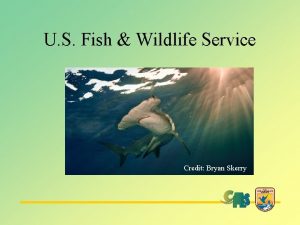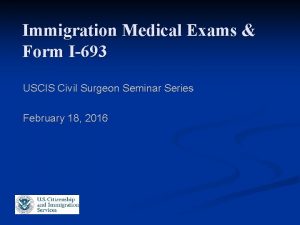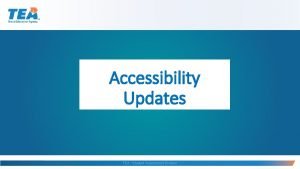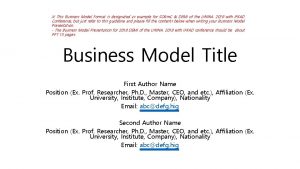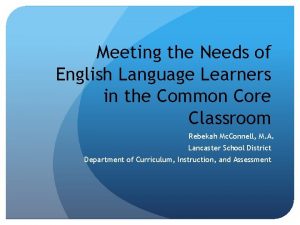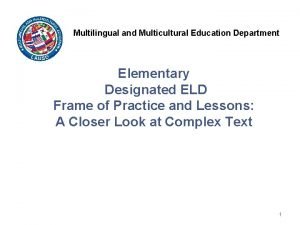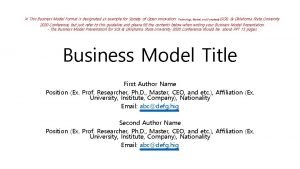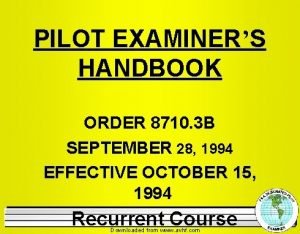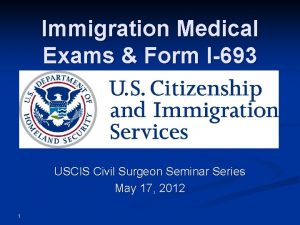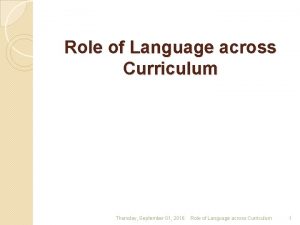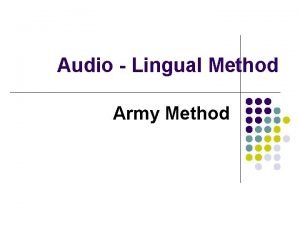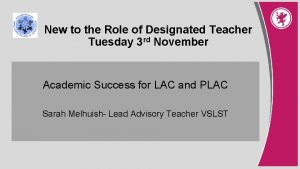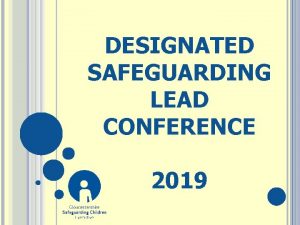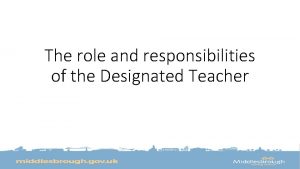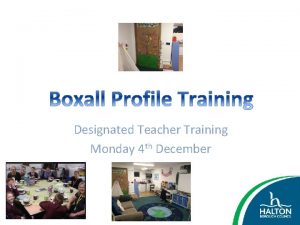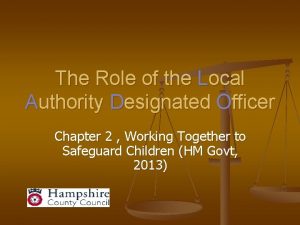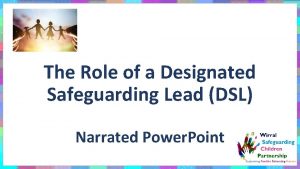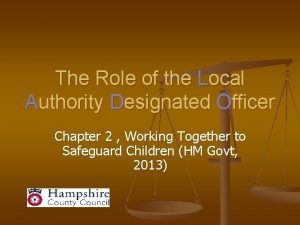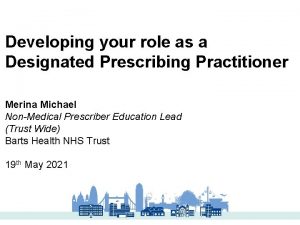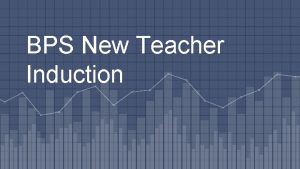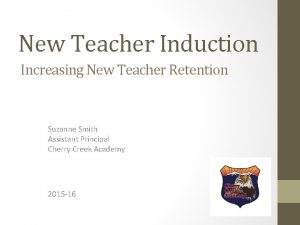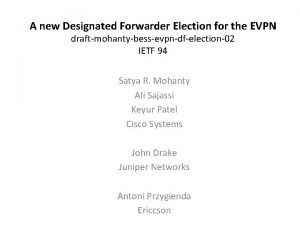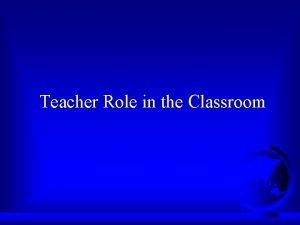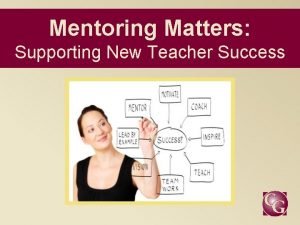New to the role of Designated Teacher supporting






























- Slides: 30

New to the role of Designated Teacher: supporting the SEMH of children looked after (CLA) and previously looked after children (PLAC) Dr Duncan Henderson Somerset Educational Psychology Service

Housekeeping • What to expect from today’s session • Sensitive information • If you need to leave • Fire alarm

AIMS • To consider Attachment Theory, impact of when early attachment is disrupted and second chance learning. • UK CLA statistics and the impact of adverse life experiences and developmental trauma. • Approaches that help children who have experienced trauma or disruption to early attachment. • The role of the Educational Psychology service with CLA and PLAC. • SEMH Toolkit. • Question time. 3

‘It is clear from research that abuse, neglect & other interpersonal trauma have a significant impact on a child’s attachment to their caregiver & then this influences behaviour patterns that affect future relationships’ (De Thierry, 2015).

Behaviour as communication • Label the behaviour firmly (not the young person), pausing, then encouraging to do the right thing • Reminding of a time you have observed the correct behaviour (in a softened voice) if possible

Defining trauma ‘A psychologically distressing event that is outside the range of usual human experience, often involving a sense of intense fear, terror and helplessness. ’ (Perry 2011) ‘Trauma happens when any experience stuns us like a bolt out of the blue; it overwhelms us, leaving us disconnected from our bodies. Any coping mechanisms we may have had are undermined, and we feel utterly helpless and hopeless. It is as if our legs are knocked out from under us. ’ (Levine 2006)

What is Attachment? From Somerset CYPD definition: “Attachment is the deep and enduring connection formed between a child and carer. ” “Attachment is not something that parents do to their children; it is something that children and carers create together. ”


UK CLA statistics - Over 60% of CLA are in care due to abuse and neglect (Df. E 2016). - Almost ½ of CLA meet criteria for a psychiatric disorder (Luke et al 2014) in comparison to 1 in 10 non CLA. - YP leaving care 5 x more likely to attempt suicide (Ch & YP’s health outcomes forum, 2012). - 23% of adult prisoners have been in care, 40% of prisoners under 21 (The Who Cares? Trust, 2016).

Handle with care Centre for young policy studies, 2006 Of 6000 young people leaving care; 4, 500 will leave with no educational qualifications Within 2 years 3000 will be unemployed 2, 100 will be mothers or pregnant 1, 200 will be homeless Only 60 will go to University High numbers go on to be homeless or in prisons (80% of Big Issue sellers thought to have been in care)

The educational progress of Looked After Children in England: linking care and educational data (2015) At KS 1 71% expected levels in reading, 61% writing & 72% maths (non CLA 90%, 86% & 92%) KS 2 the gap widens, 48% expected academic level (non CLA 79%) GCSE’s – 14% had 5 A*-C’s (non CLA 53%) - We know SEN are far more common amongst CLA - Early admission into care associated consistently with better outcomes (suggesting those who come into care later have more challenging difficulties) - School & placement changes are risk factors for ed. outcomes - Absences & exclusions also explain substantive variations (CIN & CLA experience between 4 and 13 times as many exclusions as other children)

Flipping the lid video

The Bonding Cycle Trusting relationship develops from having needs met. Need Arousal Trust Parent meets baby’s needs – by feeding, changing, or holding etc. Baby experiences a need – hungry, wet, want to be held etc Gratification Baby communicates need – usually by crying.

Attachment Theory • Infants programmed to seek an attachment figure • Secure base allows for exploration • This relationship influences child’s view of the world: dependable or hostile.

Breaking the Bonding Cycle Trusting relationship does not develop. Need Arousal No Trust Parent does not meet baby’s needs. Baby experiences a need – hungry, wet, want to be held etc No Gratification Baby communicates need – usually by crying.

Brain Plasticity ‘Neurons that fire together wire together. ’ Synaptic pruning in adolescence. The power of second chance learning & its impact upon the brain.

What helps/supports children who have experienced trauma/lack of attachment?

Building relationships Key adults • Getting to know the child • Developing a positive relationship

PLACE/PACE - Dan Hughes üPlayfulness – focus on positive, provide opportunities for laughter and enjoyment. üLiking - Liking them if not the behaviour. üAcceptance –accept the young person, not necessarily their behaviour. üCuriosity – be interested and offer ways to help child or young person to reflect and make sense of experiences. üEmpathy – show that you are trying to understand that you care about what the young person is feeling. 19

Emotion Coaching 1. Become aware of emotion, especially if it is of a lower intensity (such as disappointment or frustration) 2. Connect and view emotion as an opportunity for intimacy and learning 3. Accept - communicate your understanding and acceptance of the emotion – empathy. . ‘I am wondering if’ 4. Reflect - Use words to describe feelings – ‘Name It to Tame It’ 5. End stage - If necessary, help them to solve problems. You may also Page 26 communicate that all wishes and feelings are acceptable, but some behaviours are not. Adapted from Gottman, J. M. & De. Clair, J. (1997). The Heart of Parenting: Raising an Emotionally Intelligent Child. New York: Simon & Schuster. Tuning in to Teens Handouts 2, 3, 4, 5 and 6 CARE

Ways adults in school can support children • Finding opportunities to nurture them • Seeing the hidden feeling of fear behind their behaviour • Showing empathy even when they are raging at you • Providing highly predictable and structured routines • Breaking down tasks into small chunks • Providing transitional objects – ‘please look after this for me for a while’ • Noticing and keeping them in mind – ‘I thought of you when…’ • Increasing any separation very slowly • Offering extra support for transitions • Planning beginnings, endings and separations • Helping them understand their emotions • Giving them strategies to calm strong emotions (5 point scale, etc. ) • Using permission/exit cards to take time out • Providing a physical space for them to retreat to (safe space) • Mediating and scaffolding peer relationships www. beaconhouse. org. uk

The role of the Educational Psychology service • How to access EPs to support CLA and PLAC • Training through the Virtual School • SEMH Toolkit

Joined Up Multi-agency Planning How to access EPs to support CLA and PLAC JUMP Meetings JUMP meetings provide an opportunity for a multi-agency team to meet together to reflect upon the impact of a Child Looked After’s (CLA’s) experiences, and to think together around the best ways of supporting them. Criteria: 1) Those children and young people missing education. 2) CLA at risk of permanent exclusion – repeat fixed term exclusions. 3) Those working with the YOT. 4) Where there is documented evidence of a well-managed graduated response (usually 2 cycles of APDR would have taken place) but schools are still stuck. https: //www. somersetvirtualschool. co. uk/our-school/

Joined Up Multi-agency Planning How to access EPs to support CLA and PLAC Whilst children with an EHCP are not excluded from the JUMP process there is an expectation that the Annual Review process is being used dynamically and is brought forward as an Emergency AR if this would be a more appropriate forum for discussion. Referrals are made by VS advisory teachers, so please do speak to your named person should you feel there is a requirement. The meetings are 2 hours long and involve; schools, carers, social care, the Virtual School & an EP - they are an opportunity to think about the child’s chronology, what the current concerns are and to jointly plan next step actions to support their wellbeing and education. https: //www. somersetvirtualschool. co. uk/our-school/

How to access EPs to support CLA and PLAC Training through the Virtual School • • • Trauma Training (3 sessions): 20 th January, 16 th March & 23 rd March 2020 Sensory Processing Training: 30 th March 2020 Advanced Trauma Training – TBC Summer Term 2020 PLAC Conference - TBC Summer Term 2020 (April 2020? ? ? ). . . and more! http: //www. supportservicesforeducation. co. uk/Training

SEMH Toolkit http: //www. supportservicesforeducation. co. uk/Article/56434

Next steps: • Identify one target for you.

Questions?

Remember. . . Look After Yourself Too!

FORMAT OF SESSION “New to the role of the DT” – supporting the SEMH of CLA & PLAC: Attachment & Trauma 40 mins on Attachment/Trauma, 20 mins on signposting & questions. Definitions of attachment (MAARG 2 hours) & trauma (Trauma 1). Behaviour as communication (Trauma 2 – slide 28). Trauma stats (Trauma 1). Theory on trauma (developmental trauma as stand alone diagnosis) [Trauma 1]. Attachment – bonding cycle (MAARG 2 hours). ACEs? ? ? [Trauma 1]. Neuroscience regarding 2 nd choice learning [Trauma 1]. What helps/Support? – Positive relationships, emotion coaching, PLACE, Conversations/support (See Trauma 2). • Signposting towards EPs (Trauma & sensory training dates, advanced trauma training, SSE website to book these, PLAC conference, Pathway to access EPs – JUMP meeting, EP Pyramid meetings, SEMH handbook/toolkit [on SSE website]). • • •
 Designated teacher training
Designated teacher training Designated port exception permit
Designated port exception permit Civil surgeon locator
Civil surgeon locator Section break slide
Section break slide Designated format
Designated format A is a work area designated and clearly marked in which
A is a work area designated and clearly marked in which Integrated eld vs designated eld
Integrated eld vs designated eld Jcids process
Jcids process Designated eld lesson plans
Designated eld lesson plans Utiitsl psa login
Utiitsl psa login Designated format
Designated format Flight examiner handbook
Flight examiner handbook Uscis i693
Uscis i693 Azure web role worker role example
Azure web role worker role example Krappmann role taking
Krappmann role taking Statuses and their related roles determine the structure
Statuses and their related roles determine the structure Silent way method student role
Silent way method student role Direct method presentation
Direct method presentation Brainstorming method of teaching
Brainstorming method of teaching Conclusion for language across curriculum
Conclusion for language across curriculum Audio-lingual method
Audio-lingual method Constructivism slideshare
Constructivism slideshare Erf requirements for teacher 2 2020
Erf requirements for teacher 2 2020 Good afternoon class
Good afternoon class Hình ảnh bộ gõ cơ thể búng tay
Hình ảnh bộ gõ cơ thể búng tay Bổ thể
Bổ thể Tỉ lệ cơ thể trẻ em
Tỉ lệ cơ thể trẻ em Gấu đi như thế nào
Gấu đi như thế nào Thang điểm glasgow
Thang điểm glasgow Alleluia hat len nguoi oi
Alleluia hat len nguoi oi

